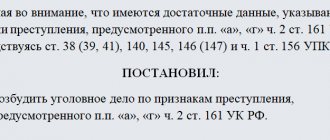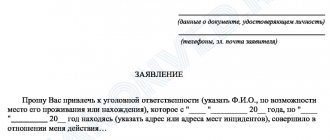According to Article 451 of the Civil Code of the Russian Federation, coercion to conclude an agreement is unacceptable, except for the cases specified in Part 1, Clause 2 of this article. In case of abuse by a counterparty who is forced to sign an agreement, he or she will be subject to criminal liability under Article 179 of the Criminal Code of the Russian Federation, and the agreement will be contested in court. In certain situations, the court takes the side of the person demanding his conclusion.
Pre-trial settlement
In all cases, without exception, the parties should try to reach an agreement without going to court. This requires the person initiating coercion to contact the potential counterparty with a claim, which will set out all the circumstances of the case and express the requirement to conclude an agreement.
This requirement must be presented officially, with the receipt of evidence of pre-trial settlement of the dispute. The pre-trial regulation procedure is based on clause.
5 tbsp. 4 APC, Art.
132 Code of Civil Procedure, Art.
The algorithm for this procedure depends on the status of the person against whom the claim is made. If this is an individual, then it is best to immediately send a registered letter with notification of receipt. To do this you need:
- Draw up a claim notice in two copies.
- Prepare an inventory of the attachment, certify the second copy with a note from the operator about the identity of the text in the attachment.
- Send a registered letter with notification.
5 working days after the sender receives the notification, if the addressee does not respond or gives a negative answer, you can file a claim.
Oral claims, messages sent via cellular or electronic communications have no legal force.
In the case of a legal entity, you can also send a letter by mail. Or use the following algorithm:
- Draw up a claim notice in two copies.
- Personally go to the potential defendant’s office, hand over one copy to the office, and make a note on the second copy that the letter has been accepted.
- Check that the employee has entered information about the received document in the incoming documentation log.
Expert opinion
Morozov Ivan Severinovich
Legal consultant with 6 years of experience. Specialization: criminal law. Has experience in defense in court.
5 working days after this, you should call the office and find out about the availability of an officially prepared response. If it is not there, or it is negative, go to court.
The Supreme Court urges not to confuse a claim for recognition of rights with a claim for state registration of transfer of ownership
In Determination No. 305-ES20-2700 in case No. A40-23052/2019, the Supreme Court recalled that if the plaintiff’s material legal interest is obvious, the courts are obliged to independently determine the appropriate method of protecting the right.
Only the fourth instance discovered an inappropriate method of protecting the right
In December 2007, Construction Equipment and Materials LLC purchased the building and the land plot underneath it from Lestekhstroy LLC. On the same day, the transfer and acceptance certificate was signed, and the property became the property of the buyer.
In accordance with the agreement, Construction Equipment and Materials LLC paid for the purchase in part; the parties agreed to make the final payment after state registration of the transfer of ownership. However, in November 2008, the Rosreestr department refused to register the transfer of rights to the disputed objects due to the fact that the land plot was seized as part of a criminal case.
Subsequently, the mention of the arrest was excluded from the register; Construction Equipment and Materials several times asked Lestekhstroy to register the transfer of ownership, but the seller did not respond to these requests. The buyer was forced to file a claim with the Moscow City Court to recognize the sale and purchase agreement as valid and to recognize the ownership of the acquired building and land. In support of its claim, the organization referred to the fact of concluding an agreement with Lestechstroy, partial payment of payment for it, transfer of property under the deed and ownership of the disputed real estate.
The first instance granted the claim, the appeal and the district court agreed with it, but the defendant filed a complaint with the Supreme Court.
Having examined the case materials, the Judicial Collegium for Economic Disputes noted that, according to paragraph 58 of the Resolution of the Plenum of the Supreme Court and the Plenum of the Supreme Arbitration Court dated April 29, 2010 No. 10/22 “On some issues arising in judicial practice when resolving disputes related to the protection of property rights and other real rights”, a person who considers himself the owner of real estate in his possession, the right to which is registered for another entity, does have the right to apply to the court for recognition of ownership rights.
Such a claim is subject to satisfaction if the plaintiff proves that the specified right has arisen. At the same time, the Supreme Court recalled, a claim for recognition of rights filed by a person whose rights and transactions in relation to the disputed property have never been registered can be satisfied if the rights to the disputed property arose before the Law on State Registration of Rights to Real Estate 1997 came into force and were not registered in accordance with paragraphs 1 and 2 of Art. 6 of this act or arose regardless of their registration in accordance with paragraph 2 of Art. 8 of the Civil Code (clause 59 of Resolution No. 10/22).
In this case, Construction Equipment and Materials LLC did not have the right of ownership to the disputed property before the entry into force of the State Registration Law of 1997. That is, the conclusion of a purchase and sale agreement and partial payment of the price stipulated by it are not grounds for recognition of ownership, the Economic Board emphasized.
A claim for recognition of a right is a claim for confirmation of a right that has already arisen. In other words, the statement of such a requirement in the dispute under consideration is an inappropriate method of defense, the Supreme Court explained. However, he added, the appeal of the Construction Equipment and Materials society for judicial protection is, in fact, aimed at state registration of ownership of the acquired property.
The Economic Board recalled that, in accordance with paragraph 3 of Resolution No. 10/22 and paragraph 9 of the Resolution of the Plenum of the Supreme Court of June 23, 2015 No. 25 on the application of certain provisions of Section. 1 part 1 of the Civil Code, in the event of improper formulation by the plaintiff of the method of defense when the material legal interest pursued by him is obvious, the court is obliged to independently determine from what legal relationship the dispute arose and what rules of law are subject to application.
The Supreme Court noted that the plaintiff repeatedly appealed to the defendant with statements about the need for state registration of the transfer of ownership, and it was precisely because of the lack of action by the management of Lestekhstroy LLC that the buyer went to court. At the same time, the panel added, paragraph 61 of Resolution No. 10/22 says that if one of the parties to a real estate purchase and sale agreement behaves in a similar way, then the other has the right to file a claim for state registration of the transfer of ownership.
According to paragraph 63 of Resolution No. 10/22, if a transaction requiring state registration is completed in the proper form, but one of the parties evades its registration, the court has the right, at the request of the other party, to make a decision to register this transaction: “A party to the transaction has no right to satisfy the claim on the recognition of the right based on this transaction, since the corresponding transaction before its registration is not considered concluded or valid in cases established by law.”
On this basis, the Court canceled the acts of the lower authorities and sent the case for a new trial to the Moscow Arbitration Court.
Experts commented on the position of the Supreme Court
General Director of the Padva and Epstein Law Bureau, Pavel Gerasimov, considers the position of the Supreme Court to be not entirely clear. In his opinion, the approach reflected in Resolution No. 10/22 is aimed at moving away from formalism. This is an indication of the need to understand the dispute on its merits, regardless of how the claims are formulated, the expert believes: “And this is true, because the court must resolve the controversial situation, and not chase the plaintiff in circles so that he can guess what exactly the court wants . This “informal” approach is common now, but is not always implemented in practice. From this point of view, the current position of the Russian Armed Forces is important.”
At the same time, Pavel Gerasimov added, the Supreme Court canceled the acts of lower authorities due to the formal approach: “Both the parties and the Court understood what the plaintiff wanted. The lower courts resolved the issue precisely based on the plaintiff’s goals. Without the case materials, of course, it is difficult to judge whether the Supreme Court could independently change the reasoning, leaving the requirements essentially satisfied. Perhaps not."
Now, when considering the case, the question of missing the limitation period will again arise based on the requirement for state registration of the transfer of rights. “If it is recognized as missing, then the formal approach of the Supreme Court, in fact, will approve the dishonest behavior of the evading defendant,” says Pavel Gerasimov.
In addition, the expert noted, in the determination, the Economic Board refers to the rules on registration of the transaction contained in paragraph 63 of Resolution No. 10/22, although the contract for the sale and purchase of real estate does not require registration. “It is not the contract that is registered, but the transfer of rights. The agreement itself is considered concluded from the date of its signing,” the expert recalled.
Alexey Petrov, a lawyer at the Moscow agency Regionservice, agreed with the Court’s point of view. “The claim for recognition is aimed at establishing the existence of an existing right. In addition, such a claim is in rem, while a claim for state registration of the transfer of ownership is, rather, of an obligatory nature. I am glad that the Economic Collegium of the Supreme Court follows the principle of contribution enshrined in Russian real estate law, pointing out that the actual transfer of an immovable property in itself is not enough to create ownership rights,” the expert said.
At the same time, he added, the result of satisfying both the claim for recognition and the claim for state registration of the transfer of ownership in this case will be precisely the making of an entry in the Unified State Register of Real Estate: “The difference is that in the second case, the plaintiff will become the owner precisely at the moment of making the entry. Therefore, in this case, when choosing the appropriate method of defense, it is enough for the court to apply the provisions of Art. 551 of the Civil Code, i.e. We are talking only about the legal qualification of the plaintiff’s claims. Since it is the court that determines the applicable rules, it decides for itself whether the requirement to make an entry in the Unified State Register of Real Estate is a claim for recognition or a claim for registration of a transfer of ownership.”
The situation is much more complicated, according to Alexey Petrov, in cases where the pleading part of the claim does not correspond to the proper method of protecting the right: for example, a person, instead of filing a vindication claim, files a claim for recognition. “Due to the principle of discretion, the court does not have the right to replace or supplement the requirements, but can invite the plaintiff to do this independently. If the plaintiff does not do this, then the refusal to satisfy the claim is quite natural,” the lawyer is convinced.
Legal partner Nikolai Sapozhnikov noted that the position of the Supreme Court is not new or revolutionary. “However, it must be recognized that the parties and, following them, the courts often do not bother themselves with a proper legal analysis of legal relations, therefore a reminder of the content of Resolution No. 10/22 should benefit law enforcement practice.”
The definition, according to the lawyer, is noteworthy rather because in it the Court clearly formulated the position that the courts had to independently determine the appropriate method of protecting the right, since the plaintiff insisted on recognizing the right of ownership for the purpose of state registration of property rights.
“In practice, courts in such circumstances always strive to explain to the plaintiff his right to clarify the subject of the claim in terms of the chosen method of protecting the right. The question remains: what should the court do if, even after such an explanation, the plaintiff insists on his chosen method of defense? Nevertheless, the principle of optionality of the civil and arbitration process remains an important guarantee of a fair trial, and the active role of the court in the adversarial process should not extend too far,” concluded Nikolai Sapozhnikov.
Who has the right to apply
The law does not restrict the right of the other party to the relationship to go to court. Entrepreneurs and organizations have the same right to file a lawsuit. The condition of the appeal is a violation of the rights and interests of the plaintiff, as well as third parties.
If the entrepreneur is obliged to make a transaction, but the consumer does not have such an obligation, the consumer has the right to go to court. Commercial organizations and entrepreneurs do not have such a right in this case.
The procedure for forcing the fulfillment of obligations under the contract
Compulsion to fulfill obligations under the contract is carried out in several stages. Initially, the proceedings are conducted without the involvement of a court. If the issue cannot be resolved amicably, you draw up and file a lawsuit. The likelihood of a positive decision depends on many factors:
- providing arguments and evidence of the guilt of the other party;
- presence at all court hearings so that the participants in the process can see that you have serious intentions;
- correct, competent preparation of all official documents;
- using the services of an experienced lawyer.
Enforcement of a sales contract is a popular issue considered by judges. If the buyer paid for the product, but the seller does not deliver it or the product characteristics do not correspond to those described in the official documentation, the issue should be resolved radically.
In situations where products are supplied, but the buyer proves that their quality is inadequate, the contract is not terminated after payment of damages. A penalty is charged and the fulfillment of the obligation in kind is controlled by the bailiff service. If the obligations are not fulfilled at all, the plaintiff has the right to terminate the contractual relationship with the defendant after collecting compensation from him.
The burden of proof in court falls on the party filing the claim to compel the performance of the contract.
Execution of a court decision to compel the execution of a contract
If the claim to compel the execution of the contract is filed correctly, and clear evidence of non-compliance with the terms of the transaction by the other party is presented, you can count on a positive decision from the judges.
The impossibility of fulfilling the obligation in kind must be proven by one of the parties. The defendant can provide clear, objective arguments as to why the terms of the transaction were not met in order to get rid of the counterparty’s claims. The court accepts evidence in the case from all parties to the conflict and, based on it, makes a final verdict.








